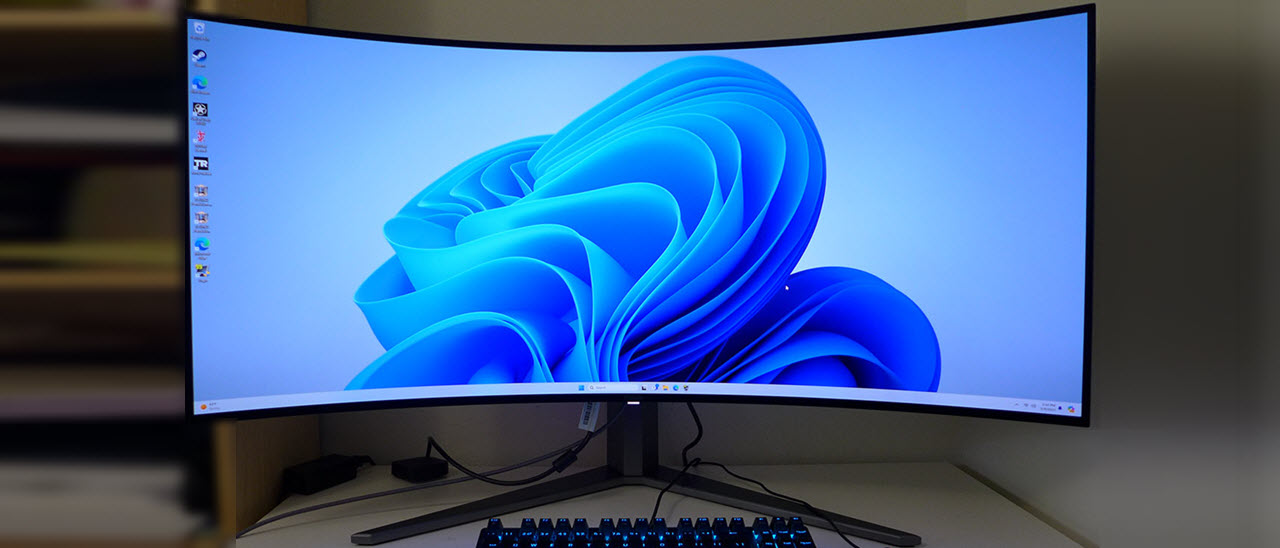Tom's Hardware Verdict
The AOC Agon Pro AG456UCZD delivers all the image quality and gaming performance of the best OLED monitors. Its unique size and shape give it an immersive quality that you can’t get anywhere else.
Pros
- +
Stunning image with saturated color and deep contrast
- +
Near 100% coverage of DCI-P3
- +
Calibration not required
- +
Top-shelf video processing
- +
Superb audio from internal speakers
- +
Premium build quality
Cons
- -
Slight gamma errors
- -
No strobe option for motion blur reduction at low frame rates
Why you can trust Tom's Hardware
The best gaming monitors come in so many shapes and sizes that buying a monitor for specific game types has become easy. First-person titles benefit from curved screens in 21:9 and 32:9 aspect ratios. By stretching the view out to the edge of the player's peripheral vision, something akin to VR goggles can be created. Except, of course, a monitor is less expensive and doesn’t sit on your head. It can also be used for other things like watching movies or productivity.
If you have the space for a wide display, there is either 21:9 or 32:9. The latter typically comes in a 49-inch size and is very wide but not very tall. It’s great for driving sims but less ideal for shooters requiring more vertical space in the viewpoint. 21:9 takes care of that but most of those products are 34 inches, which is not really encompassing. For a genuine surround feel, check out the 45-inch AOC OLED I will review. Part of the Agon Pro line, the AG456UCZD is incredibly immersive with an 800R curve, WQHD 3440x1440 resolution, 240 Hz refresh rate, Adaptive-Sync, HDR and wide gamut color. Let’s take a look.
AOC Agon Pro AG456UCZD Specs
| Panel Type / Backlight | Organic Light-Emitting Diode (OLED) |
| Screen Size / Aspect Ratio | 45 inches / 21:9 |
| Row 2 - Cell 0 | Curve radius: 800mm |
| Max Resolution and Refresh Rate | 3440x1440 @ 240 Hz |
| Row 4 - Cell 0 | FreeSync 48-240 Hz |
| Row 5 - Cell 0 | G-Sync Compatible |
| Native Color Depth and Gamut | 10-bit / DCI-P3 |
| Row 7 - Cell 0 | HDR10 |
| Response Time (GtG) | 0.03ms |
| Brightness (measured) | 400 nits SDR |
| Row 10 - Cell 0 | 635 nits HDR |
| Contrast | Unmeasurable |
| Speakers | 2x 8w |
| Video Inputs | 1x DisplayPort 1.2 |
| Row 14 - Cell 0 | 2x HDMI 2.0, 1x USB-C |
| Audio | 3.5mm headphone output |
| USB 3.2 | 1x up, 4x down |
| Power Consumption | 51w, brightness @ 200 nits |
| Panel Dimensions WxHxD w/base | 39.1 x 20-24 x 14.1 inches (992 x 509-609 x 359mm) |
| Panel Thickness | 2.7 inches (220mm) |
| Bezel Width | 0.35 inch (9mm) |
| Weight | 29.4 pounds (13.35kg) |
| Warranty | 3 years |
When you see a curve radius of 800R, take notice: it means a very tight curve. A circle of AG456UCZDs would make the user claustrophobic with an enclosure just 1.6 meters across, 63 inches, or just over five feet. When you sit in front of this monitor, two or three feet away, the sides aren’t far from your ears.
The resolution is WQHD or 3440x1440 and screen is 45 inches diagonal in a 21:9 aspect ratio, which makes pixel density 83ppi. That’s about the same as a 27-inch FHD monitor, so the AG456UCZD won’t match the clarity of a smaller screen. But that’s not the point. The OLED panel provides a stable 240 Hz, so motion resolution is perfect at speeds over 200 fps. It also has the infinite contrast and rich color I’ve come to be spoiled by in the OLED genre. With over 98% coverage of DCI-P3, it’s extremely colorful. It achieves this without a Quantum Dot layer, so it delivers high brightness, around 400 nits for SDR and 635 measured for HDR.
Out-of-the-box color accuracy is solid, with no need for calibration. For my sample, I made only a change in gamma to achieve a superb image for both SDR and HDR content. There are plenty of picture modes and tweaks if you prefer a different look. AOC has included the choice of constant or variable brightness, which is something only a few OLEDs offer.
Video processing is exemplary thanks to the 240 Hz refresh rate and also flawless Adaptive-Sync operation. The AG456UCZD delivers G-Sync and FreeSync over a 48 to 240 Hz range. It has been certified by Nvidia and also for FreeSync Premium. There’s no strobe option to address slower frame rates, so operating it below 144 Hz will produce a little motion blur.
As part of the Agon Pro line, the AG456UCZD is a premium build from top to bottom. You get a solid stand, LED lighting, decent internal speakers, plenty of USB options, and even a handheld remote. It’s premium priced, too, at around $1,400 at this writing. But this is typical for the category, and there aren’t any other monitors like it. Most ultra-wides are smaller at 34 or 35 inches with gentler curves. A 45-inch OLED screen with 800R is definitely unusual.
Get Tom's Hardware's best news and in-depth reviews, straight to your inbox.
Assembly and Accessories
The AG456UCZD’s three parts come out of a suitably large carton filled with crumbly foam. The stand is substantial and assembles with a captive bolt. To attach the panel, find the two large screws in the package, and the included Phillips-head screwdriver. The fulcrum looks small for a panel this large, but it is more solid than it appears. Once completed, it’s very solid and stable. A small box has the cable bundle, which includes USB-C, DisplayPort, and HDMI,, a power cord, and a remote with two AAA batteries.
Product 360

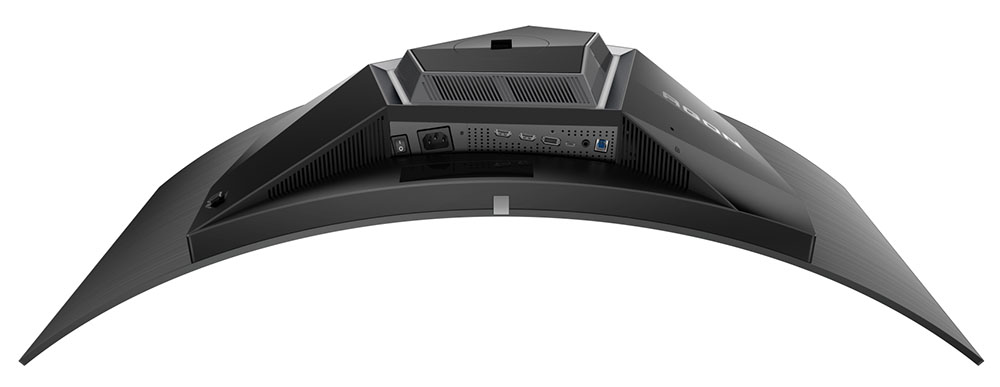
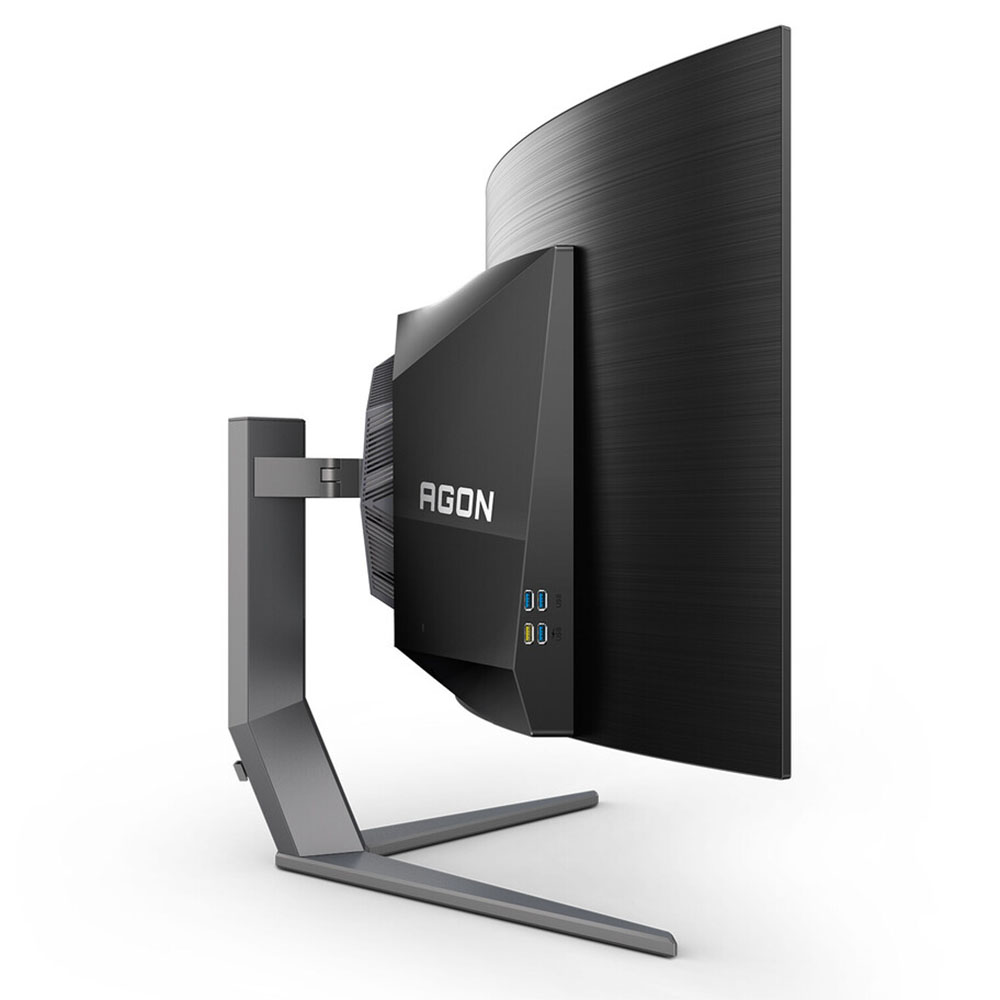

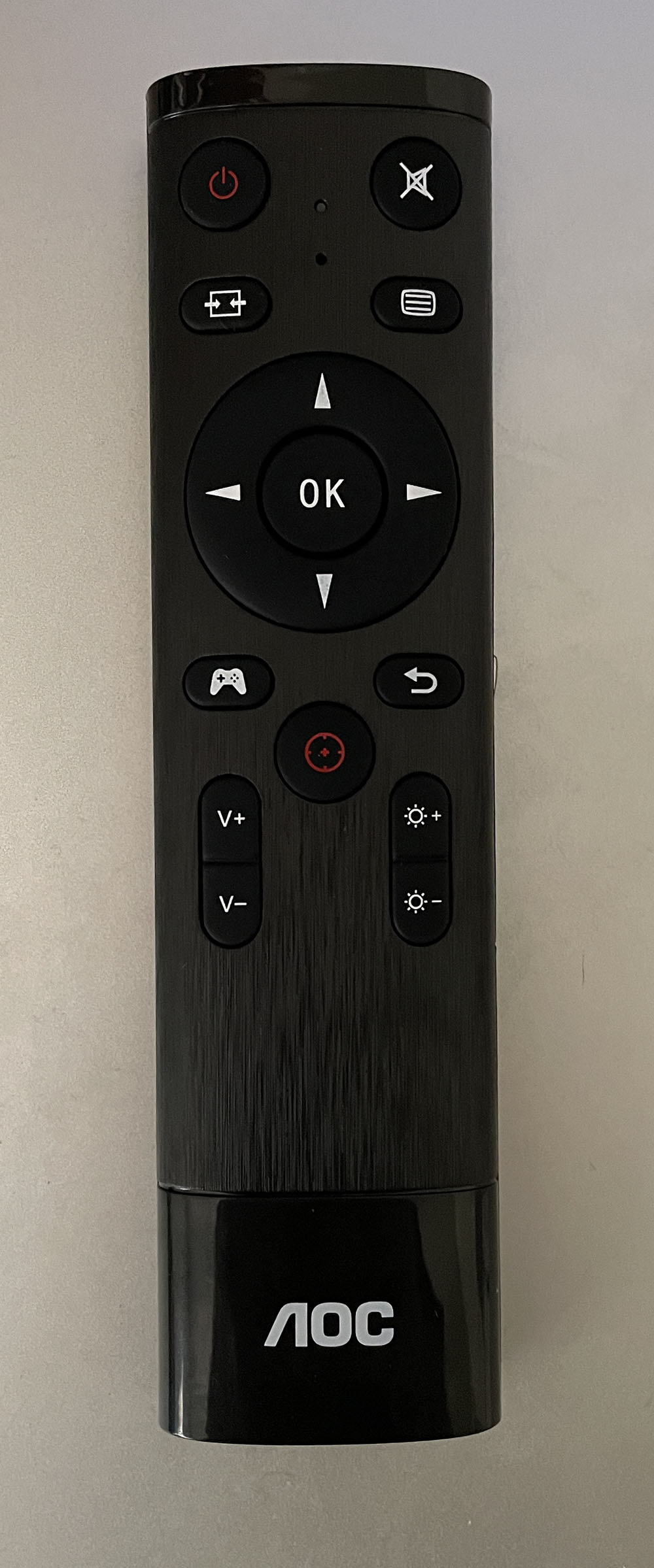

The AG456UCZD has a large footprint but isn’t quite as wide as a 49-inch 32:9 model. What you notice most is its significant height and tight curve. The screen fills your viewpoint both vertically and horizontally. When you sit three feet back, sound reflects into your ears from the screen. It’s a unique experience you can’t get from any other monitor.
The stand is very wide and deep, more than up to the task of supporting the panel’s weight. It offers full ergonomics with four-inch height adjustment, 5/15 degrees tilt, and 17 degrees swivel to either side. Movements are firm and free of play. The AG456UCZD exudes premium quality all the way.
The LED lighting is arrayed around the attachment point in the back with colorful effects that play from an asymmetrical hexagon. This shape integrates chiseled features and the word Agon to create a unique look. The panel is finished in black with a brushed texture, while the stand is a matte gray. The base is solid metal with a plastic-covered, metal-cored upright. The single control is a joystick protruding from the component bulge. Also on the bulge, on the left side, are four convenient USB ports, one of which supports fast charging.
Underneath are two HDMI 2.0 and one DisplayPort 1.4, plus a USB-C with DP capability and 90 watts of power. A USB-B upstream port supports KVM functions for your favorite peripherals. The HDMI ports are limited to 120 Hz and 2560x1440 for gaming consoles. You also get a 3.5mm headphone jack. The internal speakers play with eight watts of power and sound better than most, with decent volume, low distortion, and good frequency range.
OSD Features
AOC uses a unique menu style for its Agon products, arranged like the traditional ribbon layout but in a vertical format. It follows the same configuration, so it will be familiar to AOC users. You can operate it with the joystick, but the remote is far more convenient.
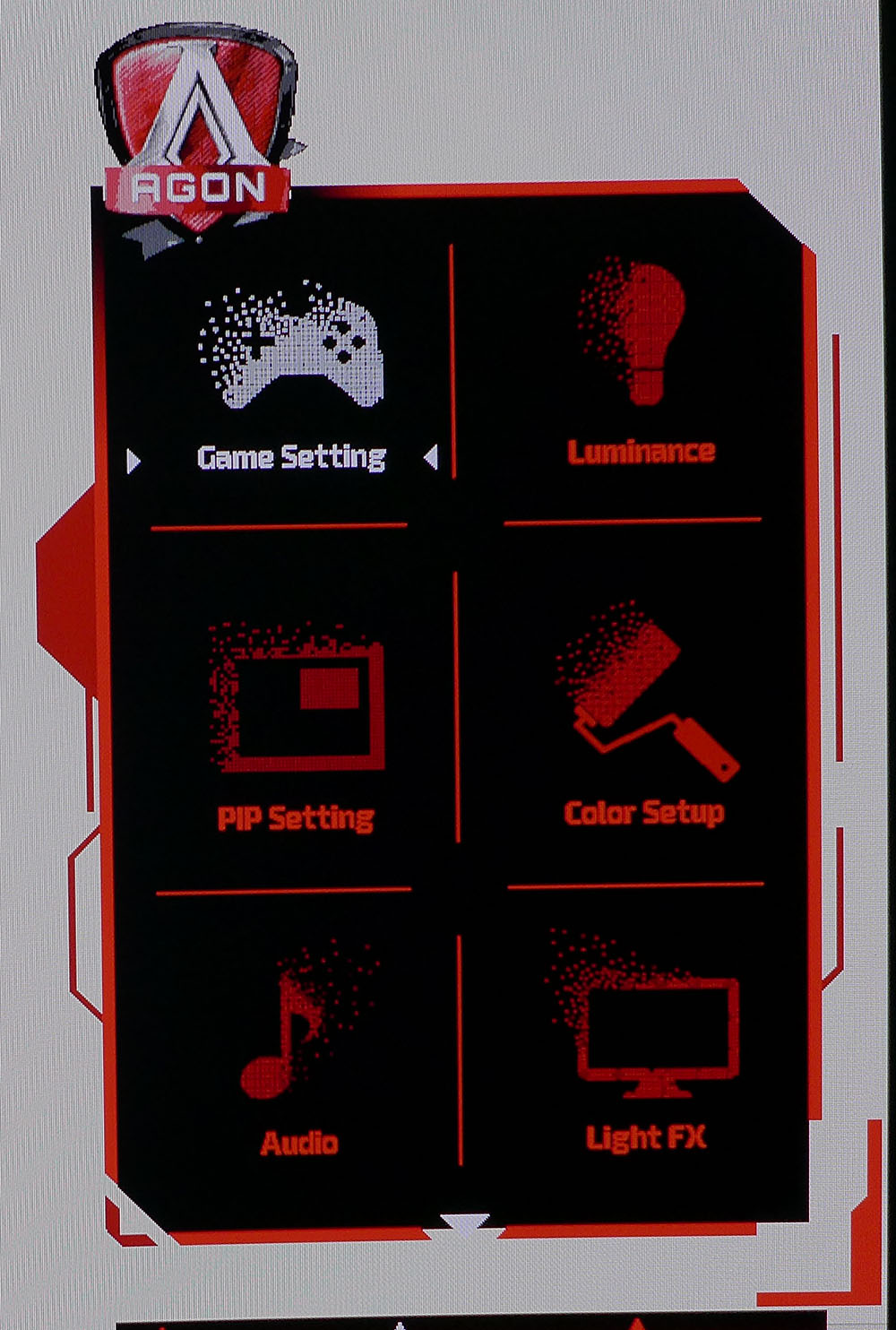
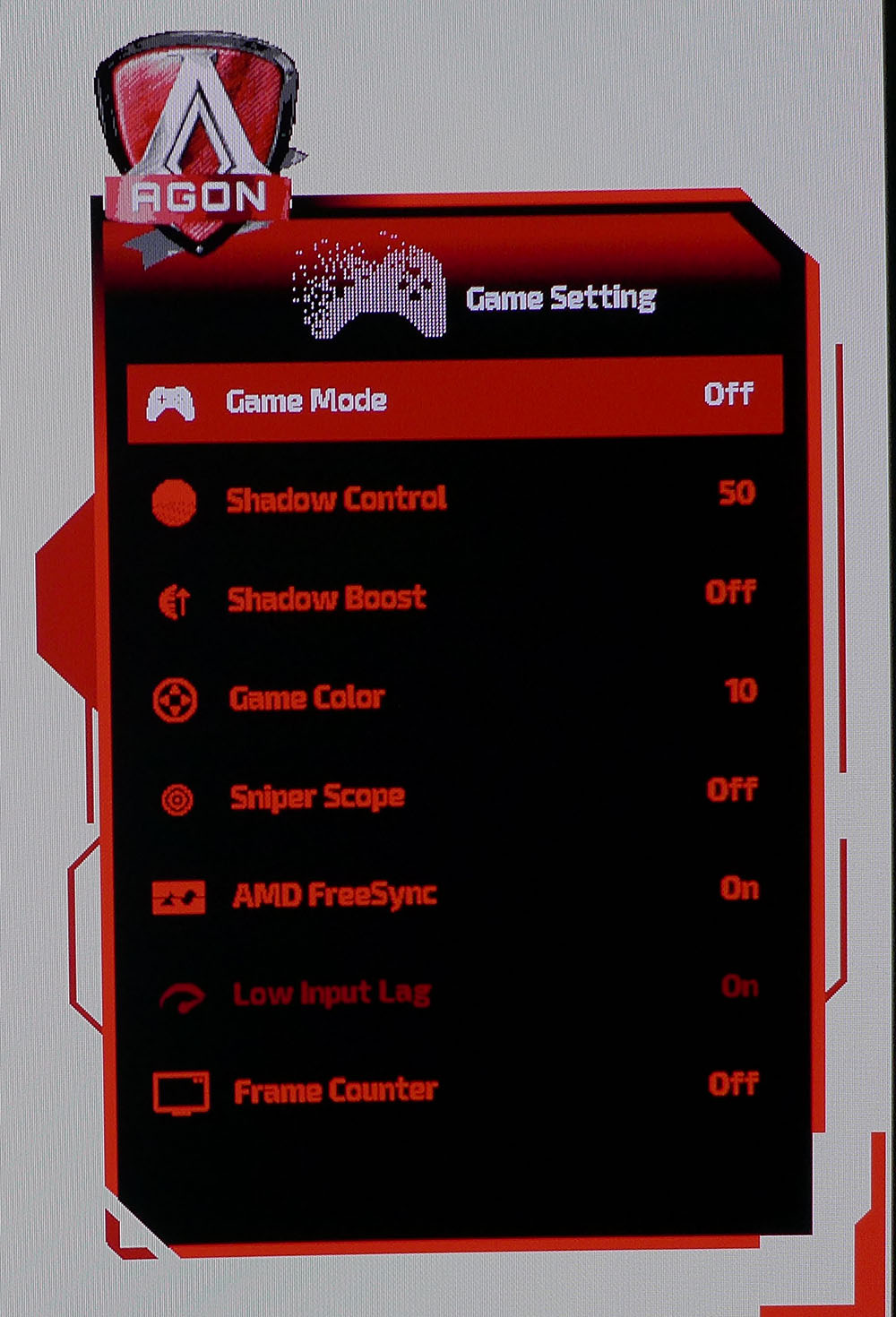

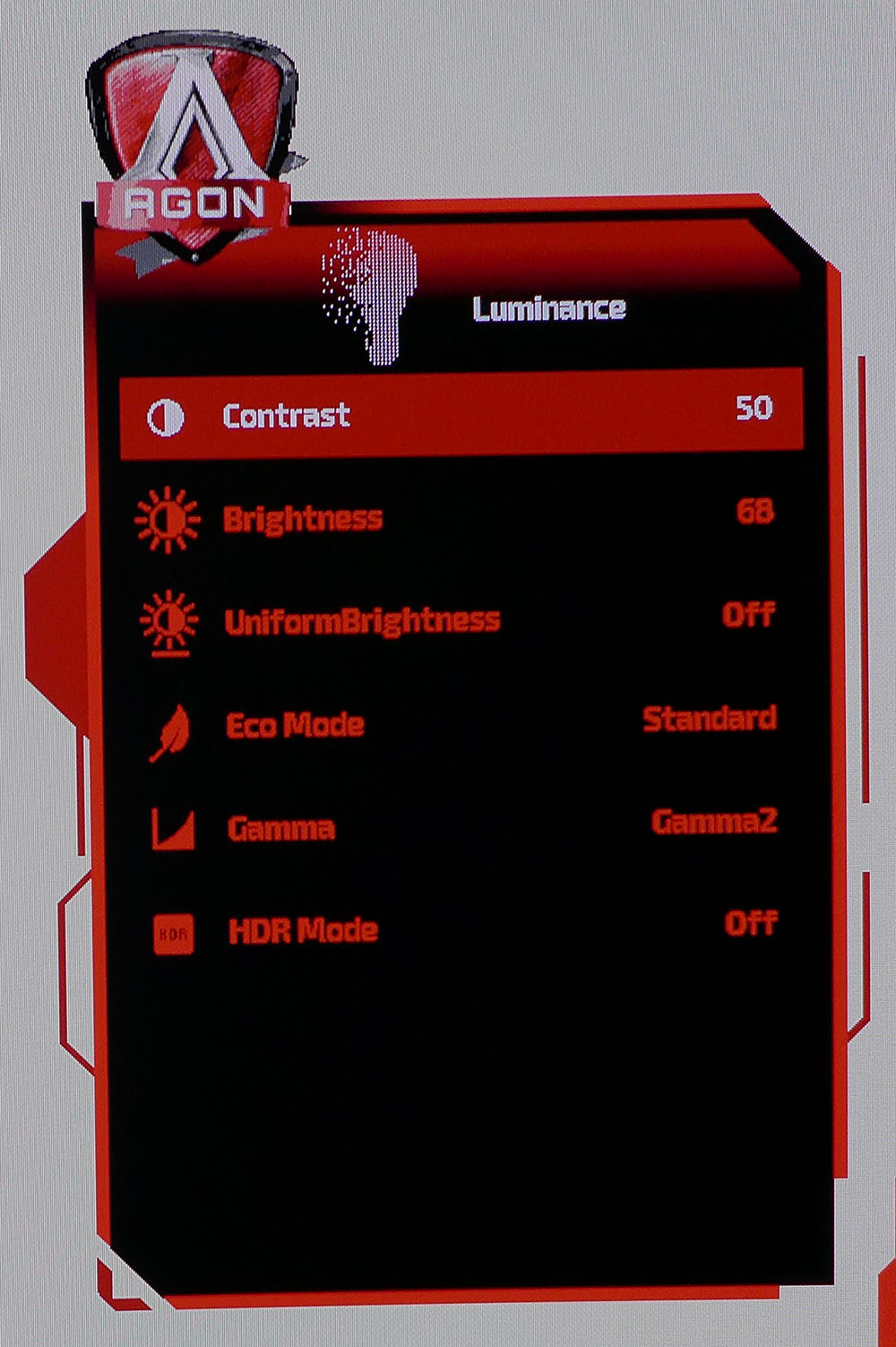
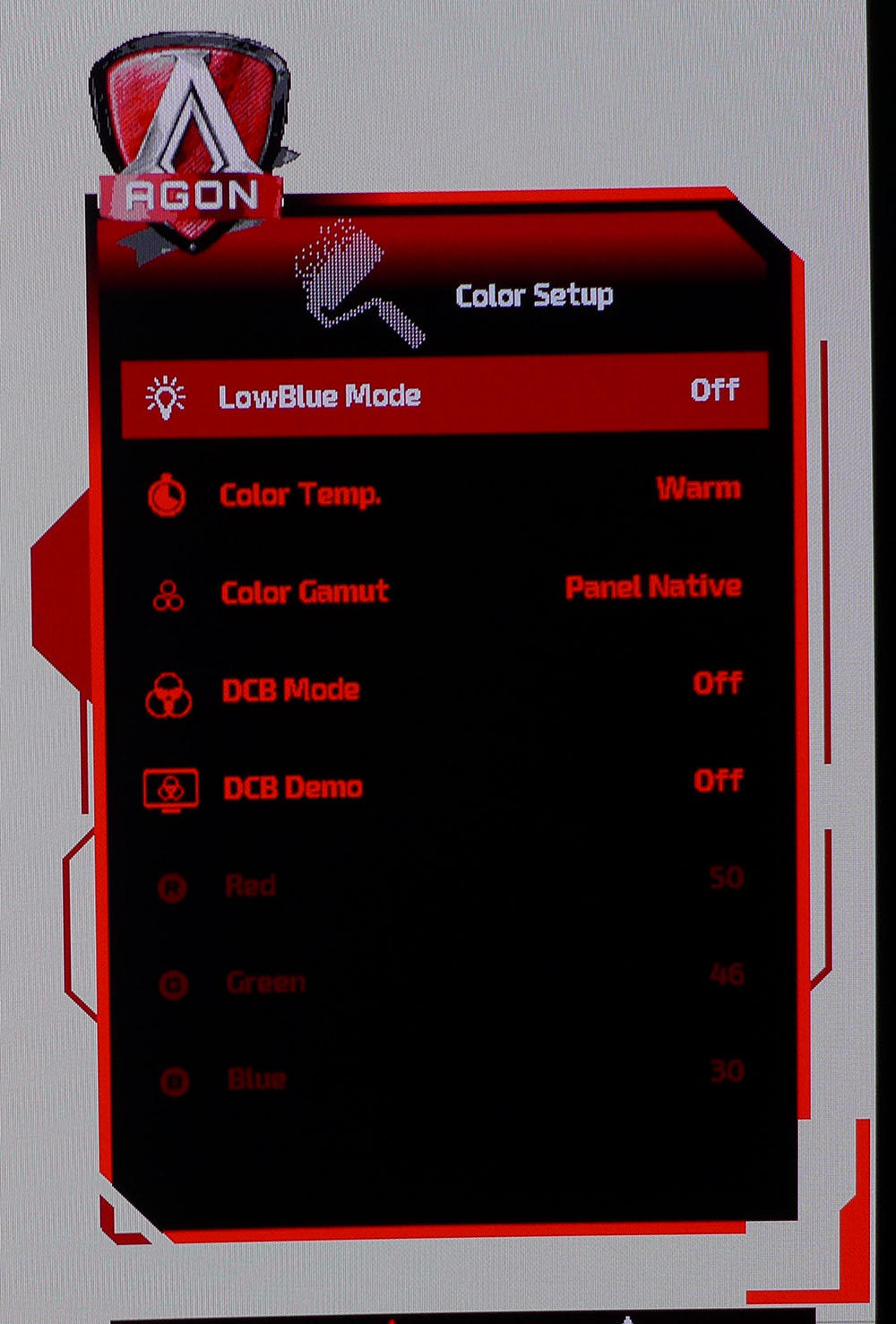

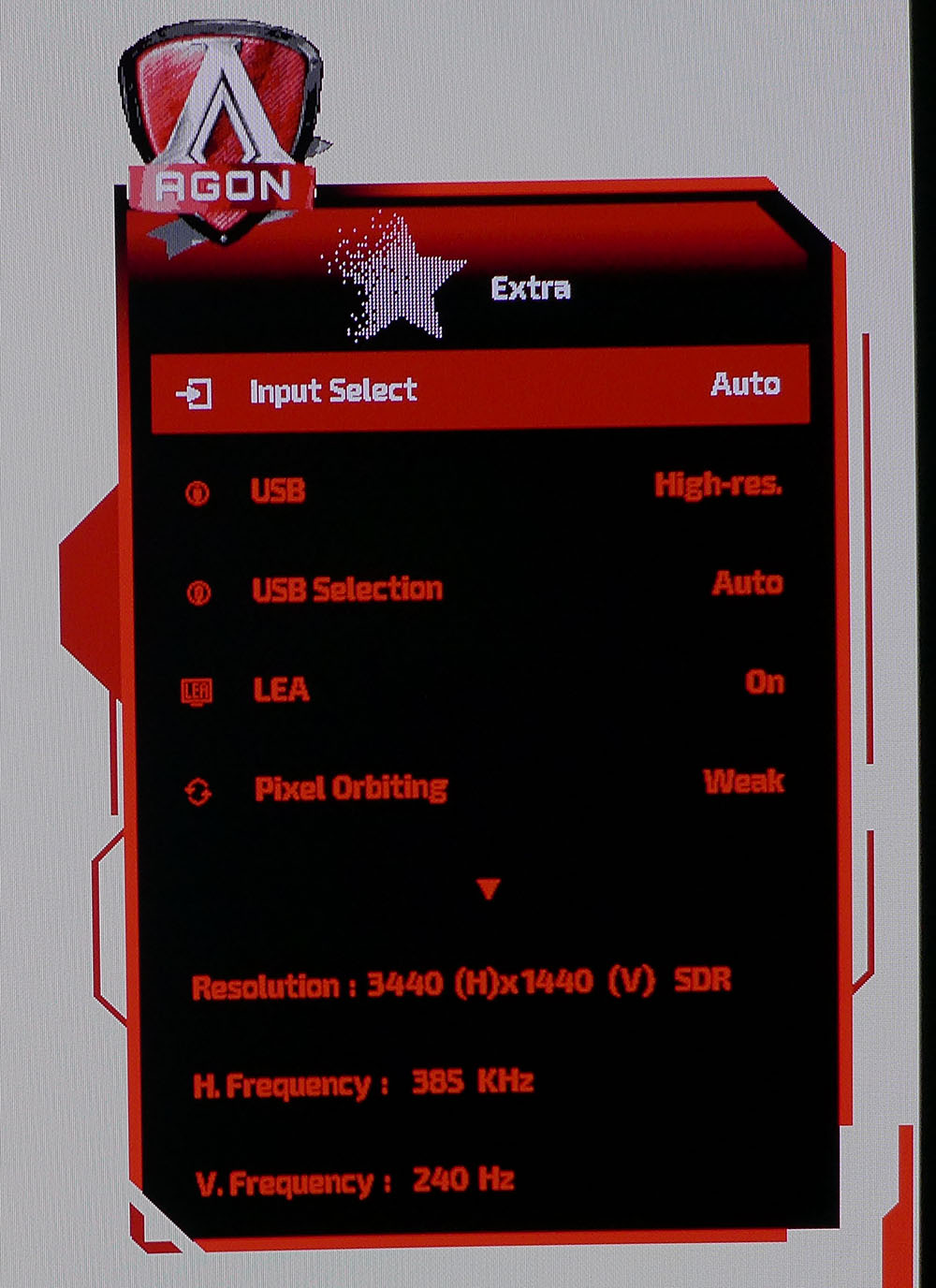
Pressing the remote’s menu button summons the main screen with eight sub-menus, six of which appear at any one time. Game Setting has an array of game modes that alter the image to suit different game types. I recommend leaving this off. You can make shadow detail more visible with Shadow Control and Shadow Boost. While this is effective, it spoils the OLED look of deep blacks. If you’re having trouble seeing dark areas of the image, turn off your room lights. You can also tweak color saturation with the Game Color control. There’s a sniper mode that magnifies the center of the screen and a frame rate indicator. The aiming points are activated by clicking the joystick down or pressing the big red button on the remote.
The Luminance menu is where you’ll find three gamma presets. I preferred the look of Gamma 2 over the default Gamma 1 setting, but that involves a compromise I’ll tell you about later. You can also turn on Uniform Brightness for SDR and HDR content. Leaving it off makes the image brighter, but introduces some visible shift in luminance when content changes. If you find the image bright enough when turned on, that’s the preferred setting. HDR Mode includes three HDR emulations for SDR content. They are a matter of user preference; try them and see if you like them. When HDR10 content is displayed, you get five HDR modes. DisplayHDR is the most accurate and best choice.
The AG456UCZD has extensive PIP and PBP options appropriate for any jumbo monitor. You can view two sources at once in either windowed or side-by-side layouts. The window can be positioned to your liking, and you can swap audio between sources.
Color Setup has three color temp presets plus a user mode with RGB sliders. I found the best results in the Warm color temp. You can choose between Native, DCI-P3 and sRGB color gamuts too.
Light FX refers to the LEDs arrayed around the asymmetrical hexagon in the back. You can choose colors and effects here or create a show using AOC’s G-Menu app from the Windows desktop. The Extra menu has an input selector, USB port control, and pixel orbiting for OLED care. You can also set a refresh routine to run every four hours if you wish. I have yet to see burn-in on any OLED screen in my possession, including a three-year-old LG OLED TV and an Alienware desktop monitor.
AOC Agon Pro AG456UCZD Calibration Settings
The AG456UCZD includes the same calibration controls as all AOC monitors, which means selectable color gamuts, three gamma presets, and a user color temp. All is well out of the box, and calibration is unnecessary, but I found the gamma looked a tad dark. Measurements confirmed that it was running around 2.36. Grayscale calibration did not positively impact, so I left the color temp set to Warm and changed gamma to the 2 preset. This brightened the image noticeably and tightened up color saturation tracking. This is a compromise, so you should try Gamma 1 and Gamma 2 to see which you prefer. For the full color gamut, leave that option on Panel Native. If you need sRGB, it’s there and accurate enough for critical work. My SDR settings are below. Brightness settings are with Uniform Brightness turned off.
For HDR content, there are four additional modes available. DisplayHDR is the best one with accurate color and luminance tracking.
| Picture Mode | Standard |
| Brightness 200 nits | 68 |
| Brightness 120 nits | 41 |
| Brightness 100 nits | 35 |
| Brightness 80 nits | 28 |
| Brightness 50 nits | 18 (min. 1 nit) |
| Contrast | 50 |
| Gamma | 2 |
| Color Temp | Warm |
Gaming and Hands-on
Gaming with the AG456UCZD is nearly a case of sensory overload. It’s wide, tall, and wraps around you. The game environment is literally in your face. Even the sound is reflected within the screen’s vision cone, creating a surround effect. This monitor is tactile in every way.
The image is stunning whether you play in HDR or SDR mode. SDR games like Tomb Raider look a bit too colorful when using the full gamut. This is a product of the AG456UCZD’s near-100% coverage of DCI-P3 and OLED contrast, which amplifies all aspects of picture quality. I could tone it down by simply selecting the sRGB gamut from the OSD. The monitor looks its best when showing HDR content, though. Doom Eternal was rich with detail and saturated color.
If you’re concerned about pixel density, don’t be. 83ppi seems low, but in practice, on this screen, you will not notice the dot structure, even when sitting close. I was two feet away, and the picture was nothing but razor-sharp and three-dimensional. Remember that OLED panels don’t have the aggressive polarization of LCDs, and the pixel gaps are very small.
Video processing was flawless in every respect. I have yet to find a 240 Hz OLED that didn’t deliver perfect motion resolution. You’ll need a reasonably fast video card to realize the AG456UCZD’s full potential. The fun starts at 200fps, for sure. Between 144 and 200 Hz, there is a little blur, and below 144 Hz there is a little more, but not as much as an LCD at the same refresh rate. It would be nice if AOC had included a strobe option because console users would surely benefit. Adaptive-Sync worked perfectly though so you won’t have to worry about frame tears.
Using an 800R monitor for work presents a few challenges but nothing that can be adapted. Documents should be kept in the center of the screen, especially spreadsheets. You can’t avoid the distortion of straight lines with such a tight radius. OLED clarity takes care of small fonts and icons, but it’s harder to focus on the task if you’ve turned your head to one side while typing. The AG456UCZD also isn’t ideal for photo editing. Small graphics are fine if you can keep them within the center third of the screen.
The AG456UCZD exudes quality from its premium build and rugged feel. The styling is game-focused but not overly distracting. Thanks to its unique shape and large size, it makes itself a conversation piece. The LED lighting creates a pleasing glow without drawing too much attention. I barely noticed its reflection from the wall behind.
The internal speakers are much better than average. They’re among the best I’ve experienced. At half volume, they are very loud and full. Remember that the screen’s curve acts as a sonic reflector. It’s almost like wearing headphones. I could turn them down quite far and still hear everything clearly. AOC has made an excellent effort here.
Takeaway: The AG456UCZD delivers a true multi-sensory experience with its tight curve, stunning image, superb video processing, and excellent sound. It puts games in your face and around your head. It’s great for anything: first-person, shooters, driving, flying, or just exploring virtual worlds. It’s fine for work if you keep your focus at the center of the screen. Gamers who try an AG456UCZD will want it, for sure.
Current page: Features and Specifications
Next Page Response, Input Lag, Viewing Angles and Uniformity
Christian Eberle is a Contributing Editor for Tom's Hardware US. He's a veteran reviewer of A/V equipment, specializing in monitors. Christian began his obsession with tech when he built his first PC in 1991, a 286 running DOS 3.0 at a blazing 12MHz. In 2006, he undertook training from the Imaging Science Foundation in video calibration and testing and thus started a passion for precise imaging that persists to this day. He is also a professional musician with a degree from the New England Conservatory as a classical bassoonist which he used to good effect as a performer with the West Point Army Band from 1987 to 2013. He enjoys watching movies and listening to high-end audio in his custom-built home theater and can be seen riding trails near his home on a race-ready ICE VTX recumbent trike. Christian enjoys the endless summer in Florida where he lives with his wife and Chihuahua and plays with orchestras around the state.
-
Makaveli Looks good but these are a no for me dawg.Reply
800R curve too aggressive( which you call super immersive) lol
1440P on 45 inch terrible PPI (so this is strictly a gaming monitor nothing else)
Also why is is DP 1.2 and not 1.4? -
Makaveli Reply
Yes I prefer a monitor that allows me to do both.Findecanor said:Yet another "gaming only" monitor that would be awful for productivity. -
oofdragon Guys pls stop this cr.. even 24 is too large for 1080p density, why waste time, effort and materials in a monitor so large but with such a poor pixel density? That size is already 4K density, it should def have been 5120x2160, it even costs $1399!! Just no,nsens this to refurb and do right next timeReply -
The Historical Fidelity Reply
I was about to reply about the 45” 3440x1440 issue when I saw yours. I totally agree, it was a big letdown when I read 3440x1440….I want to replace my 10 year old 34” 3440x1440 curved monitor but I’m not paying for a side-grade (I regard the worse PPI to offset the larger size of this monitor so “side-grade”)oofdragon said:Guys pls stop this cr.. even 24 is too large for 1080p density, why waste time, effort and materials in a monitor so large but with such a poor pixel density? That size is already 4K density, it should def have been 5120x2160, it even costs $1399!! Just no,nsens this to refurb and do right next time
This article got my hopes up as a 45” 21:9 2160p ultrawide OLED with an aggressive curvature is exactly what I want lol. Too bad… -
kookykrazee Wow! $1400 for a gaming only curved monitor? For this same price I could have a 4K TV that would do the job nearly as well for both gaming and production.Reply
